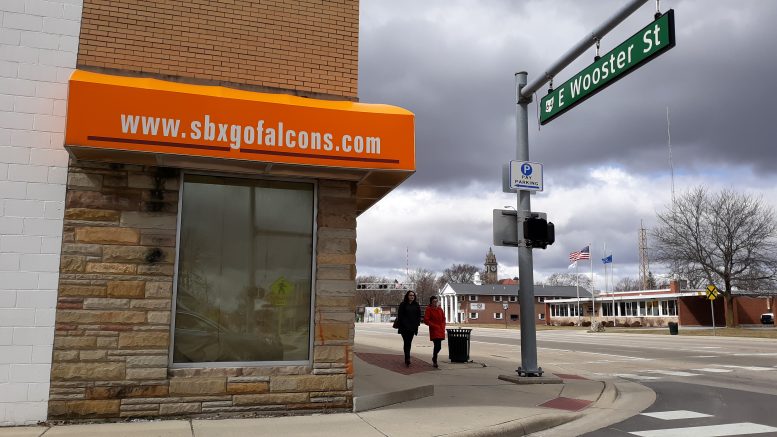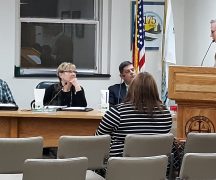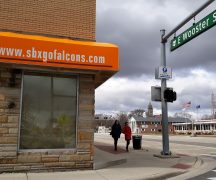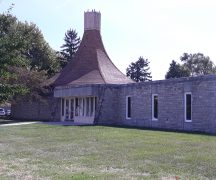By JAN LARSON McLAUGHLIN
BG Independent News
Bowling Green took a jab to the gut last week in the release of a study on the East Wooster Street entrance to the community.
The “strategy for redevelopment,” conducted by Development Strategies of St. Louis, pulled no punches as it pointed out where the city has gone wrong, and where it needs to change course to avoid a downward spiral.
The university and historic downtown are definite draws for the community, the study stated. But East Wooster Street – the front porch of the community – is littered with “haphazard development and poor quality buildings.”
The study concluded that it’s not enough that the city has made minor changes to the zoning code, and that BGSU has purchased of some lots and demolished of some eyesores on East Wooster Street.
To compete with other communities, especially other university towns, the city and BGSU need to take some control to promote healthy development along East Wooster.
Mayor Dick Edwards discussed the “painful truth” of the study last week with City Council.
“Bowling Green has a major image problem that needs to be fixed,” Edwards said of the report. “The condition of the city is placing the university at a competitive disadvantage in attracting students.”
It’s not just student enrollment that is at risk, according to the study. Both BGSU and Wood County Hospital have reported difficulty attracting talent because the community appears to lack “quality of life” characteristics.
The report has an “unmistakable sense of urgency,” Edwards said.
“The simple truth is that we as a community cannot afford the economic losses associated with declining enrollments,” the mayor said.
Following are some conclusions and recommendations from the study:
First impressions really count
Bowling Green is a far more impressive community than its first impression indicates. It has two major assets that many communities would be envious of: a public university and a charming, historic downtown.
Even so, the main corridor that welcomes visitors to the city and connects these destinations gives a negative impression that is hard to overcome. The investments BGSU has made in the Stroh Center and Falcon Health Center set a new standard for quality; however, both public and private investment will be needed to infuse the 1.8-mile corridor with vitality.
Behind in economic development trends
The national economy is changing, but Bowling Green has not adapted its approach to economic development. The city’s efforts in regards to industrial/manufacturing jobs have proven fruitful, but this singular focus has come at the expense of knowledge-based industries that are growing and are expected to become increasingly important in the future.
This blue-collar focus needs to be balanced with a broader vision of growth that will lead to greater prosperity in the long-term, and this is going to require a new strategic direction that is supported by all members of the community.
People are searching for quality of life
People are increasingly choosing where they want to live based on the quality of life. Therefore, the quality of place (amenities, public space, walkability, etc.) is becoming a critical component in attracting and retaining the next generation of people who will call a community home.
At least two major institutions, BGSU and Wood County Hospital, have clearly stated that the quality of the city, and the state of Wooster Street in particular, are negatively affecting their ability to attract talent. Potential employees don’t see the amenities they desire and find it easier to go elsewhere.
Top students and their parents come to the community and don’t see it as a fun, progressive place they want to spend the next four or more years in. Bowling Green has a major image problem that needs to be fixed.
There’s no time to wait …
Bowling Green needs to make large strides in quality of place, or risk declining enrollment for its biggest employer. The number of college bound students is likely to decline substantially starting in the year 2025.
Officials at BGSU are keenly aware of the challenge before them. Attracting students is going to be increasingly competitive, and students are choosing where to attend based not only on the quality of the campus and educational programs, but increasingly based on the quality of the community where the school is located.
BGSU is going head to head with institutions in cities that offer a much higher quality of place than Bowling Green – ones that have facilitated redevelopment in their downtowns, invested in the quality of their streets, feature high quality amenities and restaurants, host numerous community events, and exude charm and character.
The condition of the city puts BGSU at a competitive disadvantage and negatively affects the ability of the university to attract students.

GOALS FOR EAST WOOSTER
The city and BGSU hope to redevelop Wooster Street into a vibrant corridor that features high-quality development with diverse retail, dining, entertainment, employment, and residential options. Wooster Street is seen as an opportunity to create a unique identity for the community that can be used to attract students, faculty, residents and employees.
City’s ‘hands-off’ approach is not working
The “hands off” approach to redevelopment must end—the types of projects the community desires and needs will not happen on their own. The economics of quality development are extremely challenged in Bowling Green, making it all the more important that the city and BGSU work together.
Robust incentives such as TIF and tax abatement will be essential and property assembly may be necessary. If these efforts are not undertaken, the next student housing project will follow the path of least resistance and happen on “easy” greenfield properties like the former Harshman site, or even worse, on the periphery of the city.
These greenfield sites are easier to develop than the alternative, but will not be as catalytic as they will do nothing to remove the undesirable buildings that are detracting from the community and hampering economic development.
If greenfield student housing development occurs, the likelihood of the community being able to support another large upscale student housing project is greatly diminished and the opportunity for a transformational project will evaporate.
The power of one transformational project should not be underestimated; undertaking the first big project can build momentum and set the tone for the rest of what is to come.
What type of development will work?
While more student housing may not appear to be the first choice of the community right now, the fact remains that it is one of the only types of products that is currently profitable enough to withstand the costly redevelopment involved along the Wooster corridor.
Additional public outreach is desperately needed to help the community understand these development feasibility issues. Community fears can be lessened by education on how increased density and architectural controls can be used in tandem to produce buildings that will be a source of pride for the city.
It is also important to help the community understand the “long game.” Once a cycle of investment occurs (a few successful projects, streetscape improvements, etc.), market demand for other products will increase as the area becomes more desirable and higher rents can be achieved.
So the young professional housing, mixed-use retail, and boutique hotels that are not possible now, may very well be possible in the future. But Bowling Green needs to take the first step and use the opportunities available now to ensure that more opportunities will be available later.
Creating a community of quality and charm
Bowling Green has an opportunity to create a distinctive place by building upon its core assets and rigorously working to improve the elements that detract from its charm.
Investments in the quality of place (amenities, streetscapes, art and events) will pay dividends in the future. These improvements will help attract the next generation of residents who will call this city home.
These same investments can be used to appeal to tourists, whose purchasing power can be used to help smooth out the slow summer months that deter many businesses from entering the Bowling Green market. These efforts will create a virtuous cycle, expanding the local economy and creating more opportunities for growth and future redevelopment.
WHERE ARE THE OPPORTUNITIES?
Midtown
In the Midtown District – between the campus and downtown – the key sites are at the northwest and southwest corners of East Wooster and Thurstin/Manville. The sites are very marketable for high-quality student housing as they are adjacent to campus and within walking distance of downtown.
The city-owned site would require relocation of one or two facilities – the fire station and a public utilities building – but the large lot depth and single-ownership still make this the ideal place to target for the first catalytic project. Development of these key sites will require many efforts including: rezoning, design guidelines and incentives.
Other “early wins” for Midtown include adaptive reuse of the dual gas stations at East Wooster and Enterprise streets.
Eds, Meds and Beds
At over a half-mile in length, the Eds, Meds and Beds District is a long stretch of road that’s going to require multiple products and development cycles to fill.
Currently the best market opportunity lies in an additional ambulatory care facility, which Wood County Hospital has expressed interest in. As before, this potential facility needs to be strategically positioned. It will need to be near the existing Falcon Health Center, but rather than building back farther into the neighborhood, this new building should be placed prominently along East Wooster Street with any parking appropriately landscaped and buffered.
There is also market support for affordable senior housing, which would tie in nicely to this expanded health care district. While the community initially envisioned this area being ideal for townhomes or other housing for young professionals, the data leads us to believe that product cannot be brought to market at this time, unless BGSU wants to give the land to their selected developer at essentially no cost.
Walkable hospitality district
Rather than identify key sites, the main takeaway for the Walkable Hospitality District is that the city needs to create a regulatory framework for development.
Standards for setbacks, landscaping, signage, architectural quality, and connectivity need to be established and consistently enforced.
The market strength of the area is apparent as many first class tenants are already in place, but those tenants are in less than ideal properties. Once these city standards are in place, and properties redevelop over time, the quality of the district as a whole will improve.
Interstate area
The Interstate District has demand for many tenants that would benefit from the large secondary market area that Bowling Green serves.
However, full-scale redevelopment of this district will be incredibly difficult, due to challenging property assembly and expensive land, which would trigger the need for substantial incentives.
As with the Walkable Hospitality District, improvement in city codes would go a long way toward improvement in the aesthetics and functionality of the area. Incentives may still be required to compel existing properties to conform to new development standards—particularly with respect to pole signs.
AGENTS OF CHANGE ARE URGENTLY NEEDED
In some instances, a leader emerges that has the energy and fortitude to push a community in a new direction and see tough projects through to the end.
More often, communities that wait for this singular “savior” fall behind. It is important to emphasize that progress needs to be made quickly, with or without a single leader.
A small group of dedicated individuals will need to work together as a team, as there is much to be done before the first shovel hits the ground—and time is of the essence.
Each new project that’s built under insufficient city standards will likely be there for another 30 years or more. Each day that passes, BGSU will face increasing pressure to let student housing development occur on “easy” sites (on-campus locations like the Harshman site) instead of catalytic sites (off-campus locations where low-quality buildings can be removed as part of the redevelopment).
Each time a prospective resident, employee, or student comes to town, Bowling Green has lost another opportunity to make a good impression.
The city
The city must switch its stance from reactive to proactive. The kind of development that will transform the image of the community will not occur on its own.
Bowling Green must find the will to get into the thick of it—helping to assemble sites, using robust incentives, recruiting potential tenants—all the tools in the book that will enable them to encourage high-quality development.
The city must also welcome Bowling Green State University as a partner and work to improve communication, develop trust and enhance collaboration.
BGSU
BGSU will likely need to take the lead on purchasing land at key sites and recruiting developers. Beyond that, the university needs a more visible presence on Wooster and throughout the community as a whole.
BGSU can leverage its resources and staff/board knowledge to infuse entrepreneurial roots (like incubators and start-up spaces) and artistic character into the community. To do so, the university will need to work with the city to enact change, much of which needs to happen outside the official campus boundaries.
Improved communication with city officials and a dialogue with the community are necessary to develop trust and support, and lay the foundation for greater collaboration.
Hospital
Wood County Hospital and BGSU have many of the same issues in regards to talent attraction, and improved quality of place is essential to the future of both entities. Therefore, both parties should strive to find a way to work together again, for the betterment of the community.
The hospital’s desire to provide additional ambulatory services along the East Wooster corridor might be the best opportunity for collaboration.
Property owners
The vision of this plan will need to be shared with local property owners to build a sense of common purpose and to find ways to harness the enthusiasm many of them have for certain elements of the plan.
Owners who are holding properties with no intent to improve them need to be encouraged to sell for reasonable prices in the name of progress.
The community
The community needs a broad engagement process to help them understand feasibility issues underlying redevelopment along the corridor.
This engagement process should include a robust online component, ensuring that the “silent majority” is being heard.
With this improved knowledge, the community will be able to shift its efforts from resisting change and new development to helping craft city requirements that will make predictable outcomes for everyone, focusing on quality and appropriate placement.
This public outreach should also be used as an opportunity to help citizens develop a deeper understanding of BGSU’s aspirations, thereby improving confidence and cooperation moving forward.
WHERE DO WE GO FROM HERE?
Regular meetings should be held with key people from the city, BGSU, Wood County Hospital, and developers like Green/Mecca and Maurer/Greenbriar. Following are some suggestions from the report for the next steps …
- Conduct an online survey to gather a broad community perspective.
- Update zoning and architectural standards – then stick by them for new development.
- Make the northwest and southwest corners of East Wooster and Thurstin/Manville a priority. Issue requests for proposals for those areas.
- Start working toward potential relocation of the fire station on East Court Street and the public utilities building on East Wooster Street.
- Start working to acquire the “SBX corner.” If the owners are unreasonable and negotiations are ultimately unsuccessful, consider a “blight study.”
- Develop an incentive policy for desired development types and locations.
- Promote adaptive reuse of parcels – particularly former gas stations.
- Develop plans for future of on-campus housing with an understanding that additional student housing on campus may limit options for redevelopment elsewhere in the community.
- Improve housing stock in city by creating a forgivable loan program for faculty/staff who choose homes in targeted neighborhoods.
- Work to get a new ambulatory hospital project in a highly visible spot along East Wooster.
- Make zoning changes to increase maximum height of buildings, plus deal with density, landscaping, parking, buffers and signs.
- Explore creation of tax increment financing to assist with development.
- Use incentives to discourage retail east of the interstate.
- Work on historic preservation.
- Focus on bike-ability and walk-ability.
- Work on interstate overpass and ramp beautification.
- Explore the opportunity for a conference center hotel on BGSU property.
- Add more community and BGSU events that target Toledo population.
- Improve outreach and marketing to bring more BG residents to campus for events.
- Use increased tourism to level out the slow summer months, enabling the community to target desired restaurants and shops.
- Consider an increase to hotel/motel tax (currently one of the lowest in the region) and invest those funds in the community.
- Partner with BGSU to encourage entrepreneurs and start-up businesses.
- Broaden definition of economic development. Don’t just focus on industrial and manufacturing. Don’t just leave it to private property owners to target specific tenants.
- Support small business growth. Consider programs such as low interest loans, rent or improvement subsidies, and district-wide marketing efforts.
- Encourage restaurant growth by exploring designation of Downtown/Midtown area as a Community Entertainment District, for additional liquor licenses.





